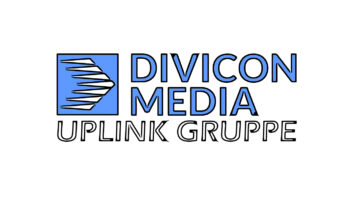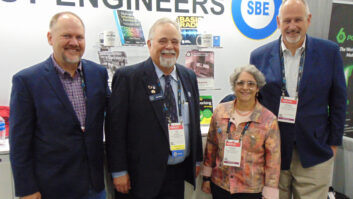Here we excerpt selected technical positions submitted by the parties to regulators for their review.
NAB Engineering Statement Cites Technical Limitations
The following are excerpts from an engineering statement prepared on behalf of NAB
by Dennis Wallace of Meintel, Sgrignoli & Wallace.
The systems as currently deployed are not interoperable. That is to say, an XM receiver cannot receive the Sirius signal and vice versa. Thus, as is true today, if the proposed merger of XM and Sirius were consummated, consumers would still need to purchase a new interoperable receiver in order to receive the signals of both providers. …
The data capacities of both the XM and Sirius systems are filled with programming and significant spare capacity is not available. Expanding the number of program offerings on the XM or Sirius platforms through more aggressive digital compression is possible but would result in unacceptable degradation of audio quality.
(click thumbnail)SDARS Technical Overview — As shown, the two SDARS providers have deployed significantly different system implementations. These differences contrast sharply, from the highly inclined elliptical orbit of the Sirius satellites to the geostationary approach of the XM satellites, to different frequency allocations of the satellite and terrestrial repeater frequencies and bandwidths, and to the different audio codecs employed by each provider. These differences cannot be easily harmonized without significant disruption to current consumer receivers, the introduction of a new interoperable radio that will work with both systems, or by obsolescing the satellite receivers of one provider and adopting the technical parameters of the other. In the latter case, it is not likely that the satellites currently in use by the providers would be capable of changing bandwidths and bit rates so as to function with the system of the other provider.
New Interoperable Receiver — FCC rules actually require that both SDARS providers design interoperable receivers, although to date neither SDARS provider has provided such a receiver. In its March 1997 Report and Order on SDARS, the FCC declined to set a specific receiver design but did require the SDARS providers to design receivers that would receive all DARS providers. …
In January 2005, the FCC’s International Bureau’s Satellite Division asked both XM and Sirius to provide an update regarding the progress on making the interoperable receiver available. On March 14, 2005, both companies replied to the FCC with a joint letter stating that, at that time, the receiver was not yet completed.
The complexity of the design task to produce an interoperable radio is significant. It would need to have wider bandwidth in order to receive both SDARS signals. It would need to have separate TDM-QPSK demodulators with various bandwidths, as well as OFDM demodulators of various bandwidths, as well as various FEC decoders. In addition it would need to have separate transport stream de-multiplexers for both services and two separate audio decoders. Also, there would be some need for software to allow the consumer to navigate the services of both providers. This is indeed a complex design task, and the fact that the joint venture has not produced any commercially available radios may be an indication of the difficulty of the project.
Bit Rates and Channel Capacity — As currently deployed, the Sirius system has a total bit rate of approximately 4.4 Mbps (Megabits per second) within the satellite component, and the XM system has a total bit rate of approximately 4.1 Mbps in its satellite component. These total capacities would not change unless the providers alter the current technical operations. The current satellite radio receivers that have been deployed to consumers are designed for these bit rates. Thus, the total capacity of the two systems will not change even if the companies merge.
…[W]ith current audio codec technologies as employed by XM and Sirius, additional numbers of audio channels (programs) would not be possible without degrading the audio quality of the existing services. That is, the total number of audio services cannot be increased without lowering the bit rates of current audio services which would likely result in degradation to the audio quality of the service. …
It is important to note that XM and Sirius use completely different audio codecs. The Sirius system utilizes a compression algorithm called PAC while the XM system uses an MPEG-AAC codec. These two audio codecs are not interchangeable. Thus, an interoperable satellite receiver would need to have the circuitry to decode both types of audio codecs, thus increasing the complexity and cost of production.
ATC Challenges MSW/NAB Conclusions
Dr. Deepen Sinha, president of ATC Labs, prepared comments on behalf of Sirius and XM.
Independently, Sirius and XM have committed substantial resources in attempting to develop [higher coding efficiency]. However, the efforts have progressed along separate tracks. While Sirius has focused on improving coding efficiency through improved psychoacoustic modeling and joined encoding (i.e., statistical multiplexing), XM has focused more on optimizing the pre-processor configuration, particularly in optimizing the overall interaction between the pre-processor and the audio encoder.
Combining these efforts likely would yield improved efficiency on both the systems. The three available tools for realizing improved efficiency through transmit side upgrades are therefore: improved psychoacoustic modeling statistical multiplexing, and, optimized pre-processing. …
In sum the [Meintel, Sgrignoli & Wallace] report simply fails to take into account the substantial improvements in system performance that have been — and can still be — achieved through upgrades in the encoding of audio programming without changes to the current generation of receivers. As noted herein, these improvements can result in additional channels of programming being made available on existing satellite systems without diminishing the audio quality enjoyed by listeners and without eliminating current channels.
Neural: NAB Got It Wrong
Neural Audio Corp. also commented on behalf of Sirius/XM.
The NAB Engineering Statement concludes … that XM and Sirius “are limited in their ability to add new program channels to their services without removing an equivalent number of existing program channels,” and that “[a]ttempts to achieve more program capacity through more aggressive digital compression and fewer bits per program would result in significant audio quality degradations likely to be unacceptable to consumers.”
[T]hese conclusions are at odds with well-established technological trends in the broadcasting industry. Continuous advancements in audio compression technologies have allowed many audio entertainment providers — including broadcasters as well as both of the satellite radio providers — to provide more programming over the same amount of bandwidth without any corresponding degradation in audio quality, even with reductions in bit rates. Neural Audio has contributed to that progress by developing and improving solutions that XM has employed successfully to substantially increase the number of channels it offers. …
[T]he conclusion that the satellite radio providers could only add new channels by subtracting others overlooks the various methods available today — including the solution developed by Neural Audio — that allow providers of audio entertainment to use their existing bandwidth more efficiently without any negative impact on audio quality. There is no evidence that either satellite radio provider has reached its “capacity” and can no longer avail itself of these technologies. …
Second, the nature of certain programming allows the companies to conserve bandwidth, even without resorting to the available technological techniques. For example, the existing systems offer seasonal sports such as the National Football League (on Sirius) and Major League Baseball (on XM). While such programming requires a large bandwidth in order to support the many games being played simultaneously, this bandwidth allocation is largely unused much of the time. Since the minimum overlap exists between the NFL and MLB seasons, both sports packages could be offered to current XM and Sirius subscribers without regard to bandwidth constraints. …
[T]he NAB Engineering Statement incorrectly identifies XM’s codec as MPEG-AAC. In fact, XM’s audio codec utilizes a proprietary version of the aacplus (MPEG 4 HE AAC) open standard, which uses Spectral Band Replication to further enhance compression efficiency. …
Fourth, the NAB Engineering Statement misstates the alleged channel capacity of both companies… [specifically] that XM and Sirius offer 148 and 123 channels, respectively, which it then claims represent the maximum number of channels that each company can provide. In fact, these figures significantly understate the number of channels provided by each company: XM now offers 178 channels while Sirius offers 134.
Thus, XM and Sirius already offer many channels above the limit at which the NAB Engineering Statement asserts audio degradation will occur. This fact alone undermines the validity of the bit-rate analysis contained in the NAB Engineering Statement.
Finally, the claim … that “the total capacity of the two systems will not change even if the companies merge” is incorrect. We understand that XM and Sirius are in stages of expanding system bandwidth by up to 25 percent of their total system capacity through the introduction of hierarchical modulation technology.
In hierarchical modulation, two separate data streams are modulated on a single carrier. The hierarchical modulation consists of a basic constellation (modulation scheme), which is the same as in the original system, and a secondary constellation (overlaid on top of the original), which carries the additional data for the upgraded system.
The upgraded system with the hierarchical modulation is backward compatible in the sense that receivers that have been deployed in the original system can continue receiving data in the basic constellation. New receivers can be designed to receive data carried in the secondary constellation, as well as those in the basic constellation. As a merged company, this new bandwidth could be pooled to support expanded programming for subscribers.













